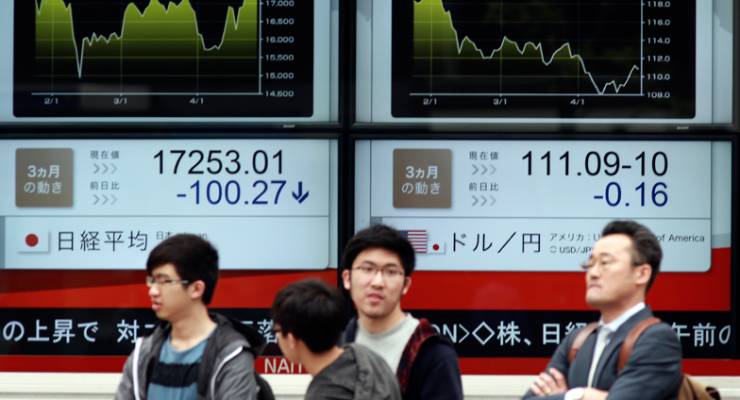
Ladies and gentlemen, the Bank of Japan … All eyes in global markets are now on the Bank of Japan’s meeting and monetary policy decision this afternoon after the US Federal Reserve and the Reserve Bank of New Zealand left their key interest rates unchanged this morning. The decisions, though, were made from different ends of the decision-making spectrum: the Fed is looking at an increase, the RBNZ at another cut. Both are waiting, watching, to see what happens globally and in their respective economies — with the biggest bar to moves probably the June 23 vote by the UK on leaving the EU and the possible instability a “leave” vote might trigger globally. Both banks didn’t mention the vote, but in the markets it is now the major factor to be confronted in coming months. Before then, though, the Bank of Japan is forecast to make some significant policy changes today to try and offset the damage done by the January 29 move to a partial negative interest regime, which has completely destabilised Japanese financial markets, politics and the economy; the yen is up 8%, the Tokyo market is down 11% since January 29. It was supposed to be the other way. Now markets are looking for the central bank to pay Japanese banks to borrow money and perhaps make other changes to try and reverse the damage done. In NZ, the Reserve Bank has a similar stance to Australia, with record-low rates that could be cut even further if the economy looks like stalling. Next Tuesday’s RBA board meeting will be the big test here. — Glenn Dyer
Budget watch #1. More problems for federal budget with the chances of a lasting boost from the recent surge in iron ore prices disappearing by the day. Chinese regulators and exchanges yesterday cracked down on speculative activity for the second time in six days, and the futures price of iron ore fell 6% yesterday to US$60 a tonne to be 17% under the most recent high of around US$68.30 set last Thursday. Markets in Dalian, Shanghai and Zhengzhou revealed further measures to slow speculation on Tuesday, including higher fees and a reduction in night hours (the changes started yesterday). This was on top of moves last Thursday to raise margin payments and cut fees to make speculating in commodities more expensive. For instance, the Dalian exchange raised trading fees for iron ore, coking coal and coke, while Shanghai said it would increase margin requirements for steel reinforcement bars and hot-rolled coils, and shorten trading hours, and the Zhengzhou exchange also raised trading charges and margin requirements for some commodities. All these changes would have been signed off on by the government and the country’s central bank and markets regulators, so they indicate growing official unease. The slide in the CPI in Australia in the March quarter and falling iron ore prices are warnings to the federal government that framing the 2016-17 budget will take more than a bit of political sleight of hand on tax and spending. — Glenn Dyer
Budget watch #2. On the face of it, the dip in headline inflation of 0.2% for the March quarter and a fall in annual price rises to just 1.3% (and a sharp fall in core inflation measures by the Reserve Bank) are good news for the economy and leaves room for a rate cut at next Tuesday’s RBA meeting. The news led our pet shop galahs erupt with a mass squawking of “rate cut looms” after completely missing the fall in the CPI and weakening in price pressures to a record low for those core measures favoured by the RBA. The fall, though, wasn’t due to underlying weakness in the economy, but one-offs such as falls in oil and fruit prices, which will be reversed in the future. The CPI report was good news — the cost of living has fallen, we have an economy with the best growth for three years (around 3% in the final half of last year), unemployment easing (5.7%), solid household consumption, but weak investment, as we all know. The housing and construction sectors are still ticking over (although it has turned down) and the services sector is solid (but the trade account is a black hole, currently). And the dip in headline inflation means the chances of a solid rise in real wages in the March quarter is on the cards when the wage price index for the March quarter is released on May 18. However, for the federal budget, the dip is bad news. It means a continuation of very weak nominal growth (which helps drive budget revenues, especially tax). And it means weak or no rises in tobacco and other taxes linked to inflation for the March quarter. While the annual CPI rate is well under the RBA’s target range of 2% to 3%, the RBA prefers to watch price pressures over time, and continues to say so in its various comments. We also have a very political 2016-17 federal budget next Tuesday as we move towards a long election campaign — all reasons for the RBA to wait and see what happens in the economy. And finally, not one economist picked the negative reading in the CPI (the market forecast was for a rise of 0.2%), so why should we (and the RBA) listen to anyone who got one of the most important quarterly bits of economic data so wrong? — Glenn Dyer







Why do rate cuts always LOOM?
I wish our professional journalists, paid to write, I don’t know, use another word. there must be another one somewhere. Not having a go at Crikey here, they correctly record that yesterday’s papers referred to rate cuts ‘looming’.
If it’s what appears in Crikey, it’s not primarily about loom per se, but rather the doom which will surely loom if the Crikey Commissariat ever succeed in having the sorts of politicians they favour in charge of our Parliaments.